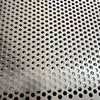Description
Introduction to stainless steel perforated plates
Stainless steel perforated sheets are a versatile and indispensable component in various industries, known for their durability, aesthetics, and functional efficiency. These panels are widely used in many fields such as building decoration, industrial filtration, ventilation systems, etc. This comprehensive guide takes an in-depth look at the key aspects of stainless steel perforated sheets, including their material composition, thickness specifications, hole shapes, pore sizes, plate sizes, and performance characteristics.
Material composition
Stainless steel perforated plates are mainly made of high-quality stainless steel, an alloy composed mainly of iron, while containing large amounts of chromium and nickel. The most common types of stainless steel used for perforated sheets include:
1. 304 Stainless Steel: Also known as 18/8 stainless steel, it contains 18% chromium and 8% nickel. It provides excellent corrosion resistance, formability, and durability. 304 stainless steel is suitable for most construction and industrial applications that require moderate strength and corrosion resistance.
2. 316 stainless steel: This type contains 16% chromium, 10% nickel, and 2% molybdenum. The addition of molybdenum enhances its resistance to chemical attack and high temperatures, making it suitable for more demanding environments such as marine applications and chemical processing industries.
3. 430 Stainless Steel: Compared to 304 and 316 stainless steel, it has a lower nickel content (about 8%). Although it is not as resistant to corrosion as the other two grades, it is more magnetic and has good resistance to oxidation. It is commonly used in decorative applications where aesthetics are paramount.
Thickness specifications
Stainless steel perforated plates are available in a variety of thicknesses to suit different application needs. Thickness can significantly affect the strength, weight, and cost of a sheet. Common thickness specifications include:
- Light duty applications: thicknesses from 0.5 mm to 1 mm for decorative purposes, signage and lightweight structural components.
- Medium-sized applications: thicknesses between 1 mm and 3 mm for building facades, medium-load-bearing structures and general industrial use.
- Heavy Duty Applications: For applications that require high strength and durability, such as heavy machinery guards or industrial filtration systems, thicknesses from 3 mm to 6 mm or more are recommended.
Hole type
The hole pattern on a stainless steel perforated plate plays a key role in determining its functionality and aesthetics. Common hole patterns include:
1. Round Hole: The most common hole type, round hole provides a balanced distribution of force and open area. They are suitable for applications that require uniform airflow or light transmission.
2. Square holes: Square holes provide a more angular look than round holes and are often used for decorative purposes or when a more structured look is required.
3. Strip holes: Strip holes consist of long, narrow openings that can be arranged linearly or staggered. They are suitable for applications that require directional airflow or filtration.
4. Hexagonal holes: These holes provide unique aesthetics while maintaining good strength characteristics. They are commonly used in architectural applications where visuals are important.
5. Decorative holes: Custom hole patterns can be created to match specific design requirements, making stainless steel perforated panels a popular choice for building facades and interior design elements.
aperture
The bore diameter on a stainless steel perforated plate can vary widely depending on the intended application and desired performance characteristics. Common aperture sizes range from the smallest 0.5 mm to the largest 25 mm or more. The choice of pore size depends on the following factors:
- Airflow or light transmission: Larger holes allow more airflow or light to penetrate, making them suitable for ventilation systems or decorative lighting applications.
- Structural integrity: Smaller pores provide better strength and rigidity, making them suitable for load-bearing applications or safety purposes.
- Filtration efficiency: In industrial filtration applications, pore sizes must be carefully selected to effectively capture particles while maintaining adequate flow rates.
- Stainless steel perforated plate
- round hole filter screen plate
- stainless steel hole plate
- round hole stainless steel plate
- round hole plate
- hole plate
Production Capacity:
500
Delivery Timeframe:
Within 30 Days
Incoterms:
CFR - Cost and Freight
CIF - Cost, Insurance and Freight
CIP - Carriage and Insurance Paid to
DDP - Delivered Duty Paid
DES - Delivered Ex Ship
EXW - Ex Works
FAS - Free Along Ship
FOB - Free on Board
Packaging Details:
按照客户要求进行包装,可采用标准出口木箱包装等
More about
Anping Senchi Metal Wire Mesh Products Co., Ltd
0-10
Employees
Not informed
Not informed
Year
Established
Business type
- Industry / Manufacturer
- Distributor / Wholesaler
- Other
Keywords
- Perforated sheet of metal
- Stainless Steel Perforated Sheets
- Safety grating
- Perforated aluminum sheet
Contact and location
-
Anping ********
-
+86 31********
-
衡水市 / 河北省 | China






